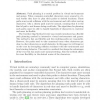Free Online Productivity Tools
i2Speak
i2Symbol
i2OCR
iTex2Img
iWeb2Print
iWeb2Shot
i2Type
iPdf2Split
iPdf2Merge
i2Bopomofo
i2Arabic
i2Style
i2Image
i2PDF
iLatex2Rtf
Sci2ools
ESA
2008
Springer
2008
Springer
Flexible Path Planning Using Corridor Maps
Path planning is a central problem in virtual environments and games. When computer-controlled characters move around in virtual worlds they have to plan their paths to desired locations. These paths must avoid collisions with the environment and with other moving characters. Also a chosen path must be natural, meaning that it is the kind of path a real human being could take. The algorithms for planning such paths must be able to handle hundreds of characters in real-time and must be flexible. The Corridor Map Method (cmm) was recently introduced as a flexible path planning method in interactive virtual environments and games. The method is fast and flexible and the resulting paths are reasonable. However, the paths tend to take unnatural turns when characters get close to other characters or small obstacles. In this paper we will improve on the cmm by decoupling collision avoidance with the environment and local steering behavior. The result is a method that keeps the advantages of t...
| Added | 19 Oct 2010 |
| Updated | 19 Oct 2010 |
| Type | Conference |
| Year | 2008 |
| Where | ESA |
| Authors | Mark H. Overmars, Ioannis Karamouzas, Roland Geraerts |
Comments (0)

